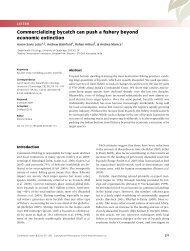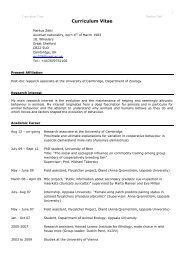Annual Report 2009 - Department of Zoology - University of ...
Annual Report 2009 - Department of Zoology - University of ...
Annual Report 2009 - Department of Zoology - University of ...
Create successful ePaper yourself
Turn your PDF publications into a flip-book with our unique Google optimized e-Paper software.
Tulay Atamert: Fly stocks maintenance<br />
Paul Avery: RNA stability in Drosophila<br />
Marcus Bisch<strong>of</strong>f: Morphogenesis and pattern formation <strong>of</strong><br />
the abdomen <strong>of</strong> Drosophila<br />
Jose Casal: Planar polarity in Drosophila<br />
Bhavna Chanana: The function <strong>of</strong> tumour suppressor<br />
pathways in early development<br />
Barry Denholm: Cell patterning and morphogenesis in<br />
renal tissues<br />
Nan Hu: Cell specification in renal tubules<br />
Joanna Krzemień: Development <strong>of</strong> adult muscles in the<br />
abdomen <strong>of</strong> Drosophila<br />
Philippe Loiseau: Intracellular transport cargo recognition<br />
by conventional kinesin<br />
18<br />
Isabel Peset-Martin: The function <strong>of</strong> motors in<br />
establishing cell polarities<br />
Pedro Saavedra: Planar polarity in Drosophila<br />
Ada Repiso: Molecular analysis <strong>of</strong> planar polarity<br />
molecules<br />
Aditya Saxena: Regulation <strong>of</strong> tubule morphogenesis<br />
Catherine Scahill: Cell specification and tissue<br />
morphogenesis<br />
Susan Wan: Intercellular signaling and branching<br />
morphogenesis<br />
Lucy Williams: The function <strong>of</strong> Kinesin-1<br />
Helen Weavers: Cell interactions underlying tissue<br />
pathfinding<br />
c) Xenopus Development<br />
The research group <strong>of</strong> John Gurdon concentrates on mechanisms <strong>of</strong> nuclear reprogramming as a route towards personspecific<br />
cell replacement. This group is analyzes the molecular mechanisms by which eggs and oocytes re-set the gene<br />
expression pattern <strong>of</strong> the somatic cell nucleus to that <strong>of</strong> an embryo cell, including the transcriptional activation <strong>of</strong> pluripotency<br />
genes. Methods include nuclear transplantation to eggs and oocytes, mutant mouse cell lines, as well as imaging<br />
and FRAP analyses.<br />
Carolina Astrand: Histone mobility<br />
Nigel Garrett: Genetic manipulation<br />
Richard Halley-Stott: Chromatin decondensation<br />
Jerome Jullien: Linker histone exchange<br />
Vincent Pasque: X-chromosomal inactivation<br />
Ilenia Simeoni: Gene transcription in oocytes<br />
Four-jointed can modify the activity <strong>of</strong> both Dachsous and Fat in vivo<br />
Jose Casal<br />
These images provide evidence that a Golgi protein kinase, Fourjointed,<br />
interacts with both Dachsous and Fat — these are large cadherin<br />
molecules. Fat and Dachsous link together as heterodimers, with Fat in<br />
one cell contacting Dachsous in a neighbouring cell. We believe that the<br />
asymmetric distribution <strong>of</strong> these heterodimers within a cell is read out as the<br />
planar polarity <strong>of</strong> that cell. What we see here are clones <strong>of</strong> cells that lack<br />
all endogenous Fat and Dachsous, but have one <strong>of</strong> these proteins added<br />
back. If the clone contains only Dachsous, then Fat is drawn to the apposing<br />
membranes <strong>of</strong> the adjacent wildtype cells and, consequently those cells<br />
are repolarised (posterior to the clone). If the clone contains only Fat, then<br />
Dachsous is drawn to the apposing membranes <strong>of</strong> the adjacent wildtype cells and this also causes repolarisation (but<br />
now anterior to the clone). Repolarisation can propagate beyond the neighbouring wildtype cells because, if Dachsous is<br />
drawn to one side <strong>of</strong> a cell it becomes depleted from the other side, and this will affect the distribution <strong>of</strong> heterodimers in<br />
the next, more outlying, wildtype cells.<br />
When Four-jointed is over-expressed in the clone expressing Dachsous, then the affinity <strong>of</strong> Dachsous for Fat is<br />
diminished, less Fat is attracted to the adjacent membrane and repolarisation <strong>of</strong> the wildtype cells is reduced.<br />
When Four-jointed is over-expressed in the clone expressing Fat, then the affinity <strong>of</strong> Fat for Dachsous is increased,<br />
more Dachsous is attracted to the adjacent membrane and repolarisation <strong>of</strong> the wildtype cells is extended. Four-jointed<br />
molecules with a change in the kinase domain <strong>of</strong> the protein have much reduced effects, arguing that Four-jointed acts<br />
as a kinase to phosphorylate both Dachsous and Fat. We have provided additional in vitro evidence is provided for these<br />
conclusions.<br />
The clones <strong>of</strong> cells are genetically marked with a mutation that makes each cell produce an increased number <strong>of</strong> very<br />
small hairs. The cells surrounding the clones and their changed polarities can be seen in the orientation <strong>of</strong> the wildtype<br />
hairs.<br />
Reference:<br />
Brittle, A.L., Repiso, A. Casal, J., Lawrence, P.A. and Strutt, D. (2010). Four-jointed modulates growth and planar polarity<br />
by reducing the affinity <strong>of</strong> Dachsous for Fat. Curr. Biol. 20, 803-810.





